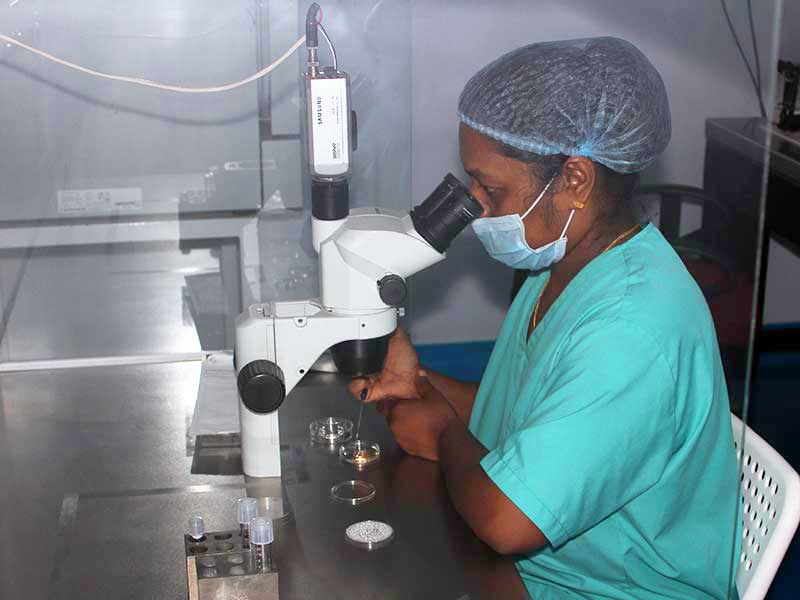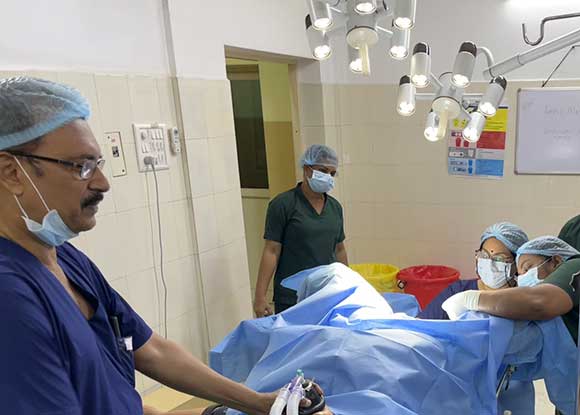Female Tube Test
TUBE TEST(HSG-Hysterosalpingogram)
The fertilization of egg & sperm happens in the tube, so a pregnancy results only when they meet each other. If tube blocked, it is not possible. There are two methods HSG and SSG for checking the tubes and Laparoscopy is the direct method of visualization. Minor blocks with mucus (like the discharge from nose) may be corrected by just the HSG, when the medicine is pushed. If not, you need a laparoscopy to find reach cause for the problem. Correction can be done in some cases where it is simple and short standing. But sometimes the block may be due to severe tubal damage and anatomy can be distorted, in which tubes cannot be corrected by surgery. In those cases IVF/ICSI is done. If there is any problems like the tubes being blocked, kinked, coiled, abnormal position (like going up), some areas dilated, tortuous like spring. Then it is best to go for a laparoscopy at the earliest. Even if the tubes do fill and spill dye, if the egg does not reach the right places due to distorted anatomy, pregnancy will not occur.
Get an appointmentWhy an HSG is Needed
A Hysterosalpingogram (HSG) is primarily used for investigating infertility or reproductive issues. Here are some specific reasons why an HSG might be recommended:
- Blocked Fallopian Tubes: To check if the fallopian tubes are open and not obstructed.
- Uterine Abnormalities: To detect abnormalities in the shape of the uterus, such as fibroids, polyps, or congenital malformations.
- Post-Surgical Evaluation: To assess the status of the uterus and fallopian tubes after surgery for sterilization reversal or tubal surgery.
- Donor sperm: For single women or same-sex female couples using donor sperm
- Repeated Miscarriages: To investigate potential structural problems contributing to recurrent pregnancy loss.
Procedure:
1. Preparation- SPositioning: You'll lie on an examination table under an X-ray machine called a fluoroscope.
- Scheduled within the first two weeks of your menstrual cycle (after your period, before ovulation) to reduce the chance of pregnancy.
- Speculum Insertion: A speculum is inserted into the vagina to hold it open.
- Cervix Cleaning: The cervix is cleaned with an antiseptic solution.
- A thin tube called a cannula is inserted through the cervix into the uterus.
- An iodine-based contrast dye is injected into the uterus and fallopian tubes via the cannula.
- AX-ray images are taken as the dye fills the uterus and tubes, helping to reveal any blockages or abnormalities.
- You may experience cramping or discomfort similar to menstrual cramps.
- The cannula and speculum are removed, and you can usually go home shortly after the procedure.




Post-Procedure:
- Recovery: You might experience light spotting, mild cramps, or dizziness. These symptoms usually resolve within a few hours to a day.
- Instructions: Your doctor may advise you to avoid intercourse for a few days and to monitor for signs of infection, such as fever or unusual discharge.
Infertility Clinic
It has survived not only five centuries, but also the leap into electronic typesetting, remaining popularised only five Power of centuries.
- Learn moreHolistic Treatment
It has survived not only five centuries, but also the leap into electronic typesetting, remaining popularised only five Power of centuries.
- Learn moreSexual medicine
It has survived not only five centuries, but also the leap into electronic typesetting, remaining popularised only five Power of centuries.
- Learn moreSurrogacy Services
It has survived not only five centuries, but also the leap into electronic typesetting, remaining popularised only five Power of centuries.
- Learn more